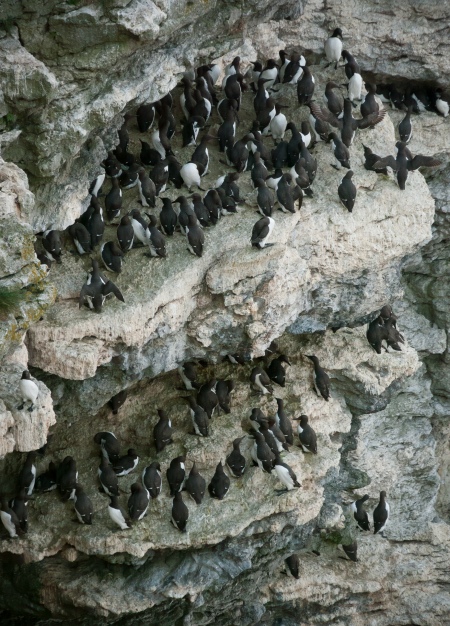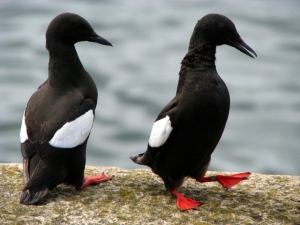The work of wildlife film makers is a good place to look at the overlap between natural history and animism, especially when the latter is taken to refer to worldviews and lifeways grounded in respectful relationship and dialogue with a wide range of autonomous and sentient other-than-human beings.(1) Animism, of course, becomes more problematic for many scientific ecologists when also defined in terms of belief in a minded or ensouled cosmic nature that includes realms and beings (‘spirits’, ancestors, deities, and so forth) that are invisible to most of us for most of the time.
Although they may be content to identify themselves as naturalists, some of our best wildlife presenters also clearly have an animist ‘self’ in the former sense. Their affection and respect for other-than-human beings is obvious, as is their willingness to engage in dialogue across species boundaries. They combine a sense of wonder at the teeming complexity of the natural world with scientific curiousity and commitment to ecological causes. Often, however, there’s a noticeable tension between these emerging animist voices and a more ‘rational’ voice schooled in the dominant discourse of scientific ecology. Perhaps not surprisingly, given the nature of mainstream media, television film-makers also seem less able than nature writers to engage with liminal and numinous phenomena that are difficult to articulate, share, record, or indeed film.
The following notes were prompted by some recent footage that, hopefully, reflects an ‘animist turn’ within Western culture. A recent example of Gordon Buchanan’s work once again showed that he is an animist in the first sense, at least when in the presence of non-human others, whilst a sequence from Charlie Hamilton James’s series, ‘I Bought A Rainforest’, included a surprising encounter with what the nineteenth century anthropologist Edward Tylor would have labelled ‘primitive’ animism, and in the process demonstrated the potentially intimate connection between these two strands of animist thought and practice.
GORDON BUCHANAN WITH GUILLEMOT-PEOPLE AND BLACK BEARS
In a recent Springwatch film, Gordon Buchanan, visited the Guillemots of Skomer, a small island off the coast of Pembrokeshire. Although populations of these birds in Scotland and North East England have crashed due to the lack of sand eels (as sea temperatures rise), as well as changing fishing practices, the Skomer birds eat sprats, so had been doing fairly well, until last winter.
Guillemots are be poster-birds for respectful relationship. Leading ornithologist, Professor Tim Birkhead, who has studied them since 1972, has described them as ‘basically people’. Because they breed in some of the densest of all bird colonies, nesting next to the same neighbours nearly every year of their twenty year life, social etiquette is vital, including ‘allopreening’ – the act of preening one’s neighbour. Imagine that. They are ‘garrolous’, though, and fall out from time to time. Like humans, they’re basically monogomous, but have occasional ‘flings’. They will preen each other’s chicks, and may be as faithful to their friends as they are to their life partners, and ledges.(2)
Young Guillemots are called jumplings, because, for them, leaving the ‘nest’, a precarious looking cliff ledge, involves hurling themselves down into the sea. Gordon Buchanan has previously filmed them bouncing down a 200 foot cliff in Mull, an ordeal that can take from two minutes to two hours. Once in the sea, their first task, incredibly, is to swim, with their parents, across to Norway -a journey of some 400 miles!
In a recent Springwatch film he reported the devastating effect of last winter’s protracted storms, that, as well as taking human lives, causing flooding and economic hardship, and remodelling chunks of the British coastline, killed large numbers of seabirds. I was impressed by the complete seriousness with which Gordon Buchanan explained, to camera, that for the surviving Guillemots, waiting on their ledges for partners that would never return, there was ‘a period of bereavement’. Presumably, since this was filmed at a site where the birds’s social relations have been studied for over four decades, this was not anthropomorphic indulgence.
According to the R.S.P.B’s Dr Euan Dunn last winter’s ‘seabird wreck’ was on a scale ‘unprecedented in living memory’, and could have a profound impact on vulnerable breeding colonies. The R.S.P.B. blame a combination of sea warming, and those huge winter storms – at one point there was an area of forty foot waves the size of the Iberian peninsular out in the Atlantic. How have the powers-that-be responded? By cutting funding for the project monitoring impacts on these birds’ survival.(3)
Gordon Buchanan’s animism, if I can call it that, has long been evident in other films, not least when he worked with Dr Lynn Rodgers filming black bears in Minnesota. During the period of filming he was accepted by a female bear who, at one point, trusted him to babysit her daughter. Later in the series, when she wandered off in search of a mate, and may have become disoriented by a storm, he made the decision to intervene on behalf of her abandoned youngster, named ‘Hope’ by researchers, over-riding the wildlife film-makers code of non-intervention. There is remarkable footage of Buchannan hand feeding his young charge. “I feed my birds in the garden through the winter, and if I didn’t do that, they would suffer, so you can’t really take that hard line of ‘don’t intervene’ because almost every single animal is affected by human beings. I made the decision that the right thing for me to do was help that animal.”(3)
In another memorable scene from the series, the mother bear patiently lead Gordon Buchanan through the forest, eventually taking him back to his vehicle. She was clearly saying, “I think it’s about time you left now!” Interestingly, in a subsequent article, Buchanan pulled back from describing the re-union between mother and cub as emotional, changing this to ’emotional, for humans’.
He points out that black bears killed forty humans in the last century, mostly because of food stress, and attributes his eventual ability to relate to them so intimately, to their human-like characteristics. This has, of course, often been commented upon in relation to the extensive lore surrounding bears. According to Richard Nelson, Koyukon men deal with surprise encounters with Black Bears by talking to them in order to reassure them that they intend no harm. The Koyukon, who traditionally regard black bears as an important food resource and ceremonial delicacy, have a complex cultural relationship with them in order to cope with the problem of killing a creature so like themselves.(5)
Gordon Buchanan was addressing the issue of recreational hunting in the U.S.A. -Hope was subsequently killed by a recreational hunter. For a British audience, unused to the presence of large predators, his conservation driven reports from wild places are likley to seem exotically dramatic, and are regularly reported in those terms. In these alienated circumstances, wildlife film-makers have a potentially important role, but need to protect their animist sensibility from romanticisation on the one hand, and ‘scientific’ objectification on the other. Gordon Buchanan is one of those who often seems to get it about right.
Part 2 will discuss Charlie Hamilton-James’s recent series ‘I Bought a Rainforest’.
Sources:
(1) Graham Harvey, Animism, Respecting the Living World, Hurst, 2005.
(2) Skomer’s Birdman Returns to keep Watch on Guillemots, Guardian, 16/7/12.
(3) South and West Wales Wildlife Trust, Save Our Seabirds appeal.
Wildlife Trusts, Massive Loss of Life for Storm Hit Seabirds
(4) Wanderlust Travel Mmagazine, Interview with Gordon Buchanan
and, a first(!), a link to right wing tabloid Mail Online, for this article which explains Lynn Rogers work and has some astonishing pictures of Gordon with the bears.
(5) Richard K. Nelson, Make Prayers to the Raven, A Koyukon View of the Northern Forest, University of Chicago Press, 1983.


